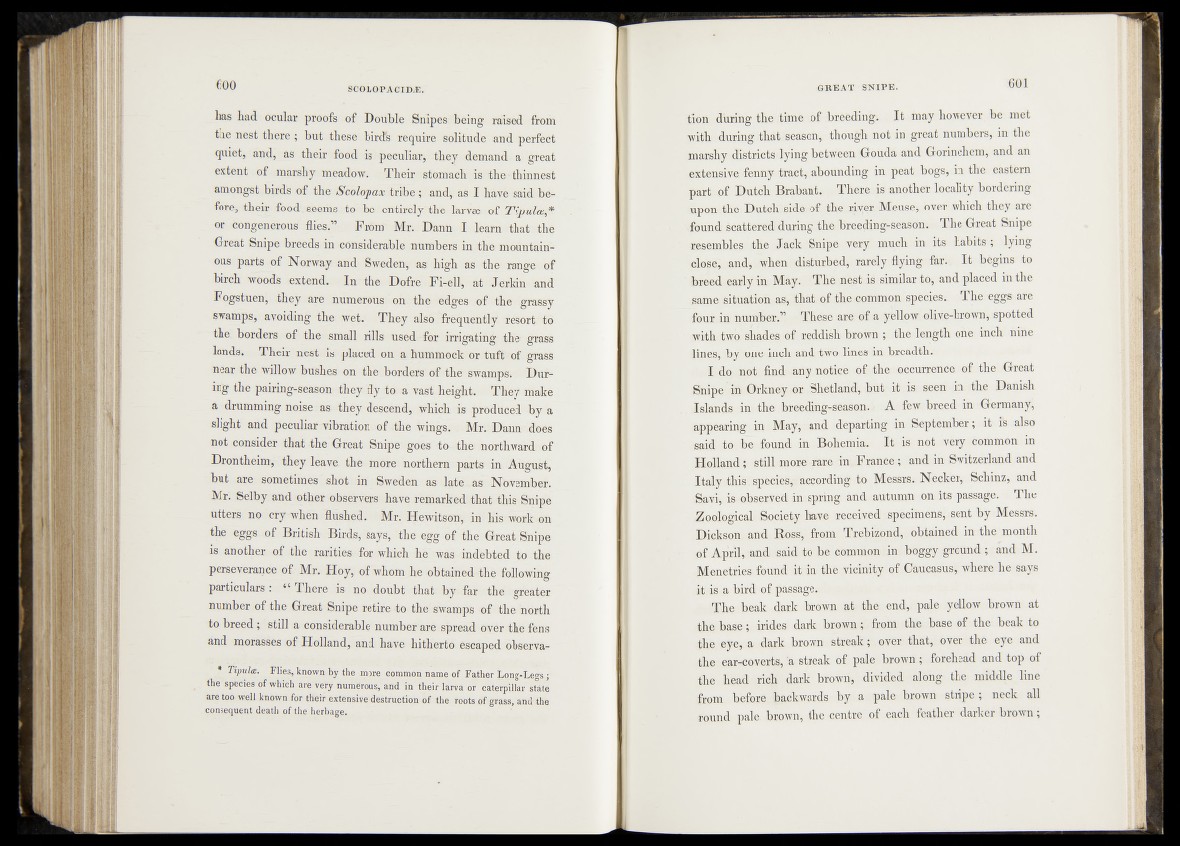
has had ocular proofs of Double Snipes being raised from
the nest there; but these bird's require* solitude and perfect
quiet, and, as their'food is peculiar, -they demand a great
extent of marshy meadow. Their stomach is the‘■thinnest
amongst birds of the Scolopax tribe; and, as I have said be-,
fore, their food, seems: to be entirely the -larvse of TipuU*
or congenerous flies.-- From' Mr. Dann I learn that the
0reat Snipe breeds in considerable numbers in the mountain-
ous parts of Norway and Sweden* as high as the? range of
birch woods extend. In the Dofre Fi-ell, at Jerkin and
Fogstuen, they are numerous on. the edges of the grassy
swamps, avoiding the wet. They also frequently, uresort to
the borders of the small rills usedrbbr irrigating the- grass
lands. Their nest is placed on a hummock or tuft of grass
near the willow bushes on the borders of the swamps. During
the pairing-season they flyto..a vast height. They make
a drumming noise as they descend, which is produced b y a
slight and peculiar vibration, of dhe wings. Mr. Dann does
not consider that the Great Snipe goes to-.-the northward .of
Drontheim, they leave, the more northern parts in. August,
but are sometimes shot in Sweden as la te . as November.
Mr. Selby and other observers have remarked.-that this Snipe
utters no crywhen flushed. Mr. Hewitson, in his work on
the eggs , of British Birds, Says, the egg of the Great .'Snipe
is another of the raritie^for which he was indebted to the
perseverance of .Mr. Hoy* ofwhom he obtainedrthe following
particulars: “ There is no doubt that by far the greater
number of the Great Snipe retire to the swamps of the north
to breed; still a considerable number are spread over the fens
and morasses of Holland, and have hitherto escaped observa-
* Tipulte. Flies, known by the more common name ofFather Long-Legs;
fhe‘ species of which are very numerous, and in their larva of caterpillar state
are too well known for their extensive destruction of the roots of grass, and the
consequent death of the herbage.
#on during th h lim h b f br^ding;; I t may however be met
y^th during that|0.easoh*. though not in great numbers, in the
marshy- Sistrictsilying. ||%t!^se.n|plouda and Gorinchem, and an
exfep.sive^fcnny:tract, abounding in peat.bogs,.in the eastern
part nf Dutch Brabant. »;,TheEf^is another locality-hordering
mponfethe Dutchisid&iO&Ih^^ which they are
vfound scatter^d|p.uringhfhe Breediug'jS^a^mfitThe Great Snipe
re sem b l^ the Jack,Snipe,'.;^e^fcmnch habits ; lying
close, and, "wh#n^is|turbed* rarely hying far.-. I t -begins to
breed early in May^SThe, nest Is similar.to,yeand placed in the
same, situation.as*.ithat of #e.common<Spebafes^ - Tjie|eggs are
dour in number.” These are ^ ^ ij|rhlloW' oli^e-brown, spotted
with Jyfcol S'had.e^Sjryddi^h'brown ; th^|Ipnjj|th. one inch nine
lines*hy!b$iejin9b and'two ldneps-dn breadth.
I find -any notice -ofc-the occurrence :s>f the Great
Snipe rft Grkney or . Shetland, b'ut-dt isrse&h an the Danish
, Islands in? the breeding-season./ A few breed in Germany*
-appearing (in May?isand departing rniSeptember; dt fs also
said^-oifefound in Bohemia. very common in
Holland; still more -rare in .France; and ^Switzerland and
Italydliisfspecies^according to Messrs. Necker, Schinz, and
Saviy is obse^yedfedmspring and autumn on. its passage. The
Zoological Society have received ..specimens, sent by Messrs.
Dickson .and Ross, from Trebjzqnd, obtained in the'month
of April, andx^iidrto-be common jin• boggy ground ; and M.
Menetriesifound it in the vicinity of-Ganoashs^^whereahe- says
i t is a bird of passage.
... The beak dark brown at the end,, pale yellow brown at
the base j irides dark brown; from the base Df the beak to
the eye, a dark brown streak; over.that, over the eye and
the ear-coverts, a streak of pale brown; forehead and top of
the head rich dark brown, divided along the middle line
from before backwards by a pale brown stripe; neck all
round pale, brown, the centre of each feather darker brown;